PONTIAC G8 2008 Owner's Guide
Manufacturer: PONTIAC, Model Year: 2008, Model line: G8, Model: PONTIAC G8 2008Pages: 334, PDF Size: 2.99 MB
Page 31 of 334
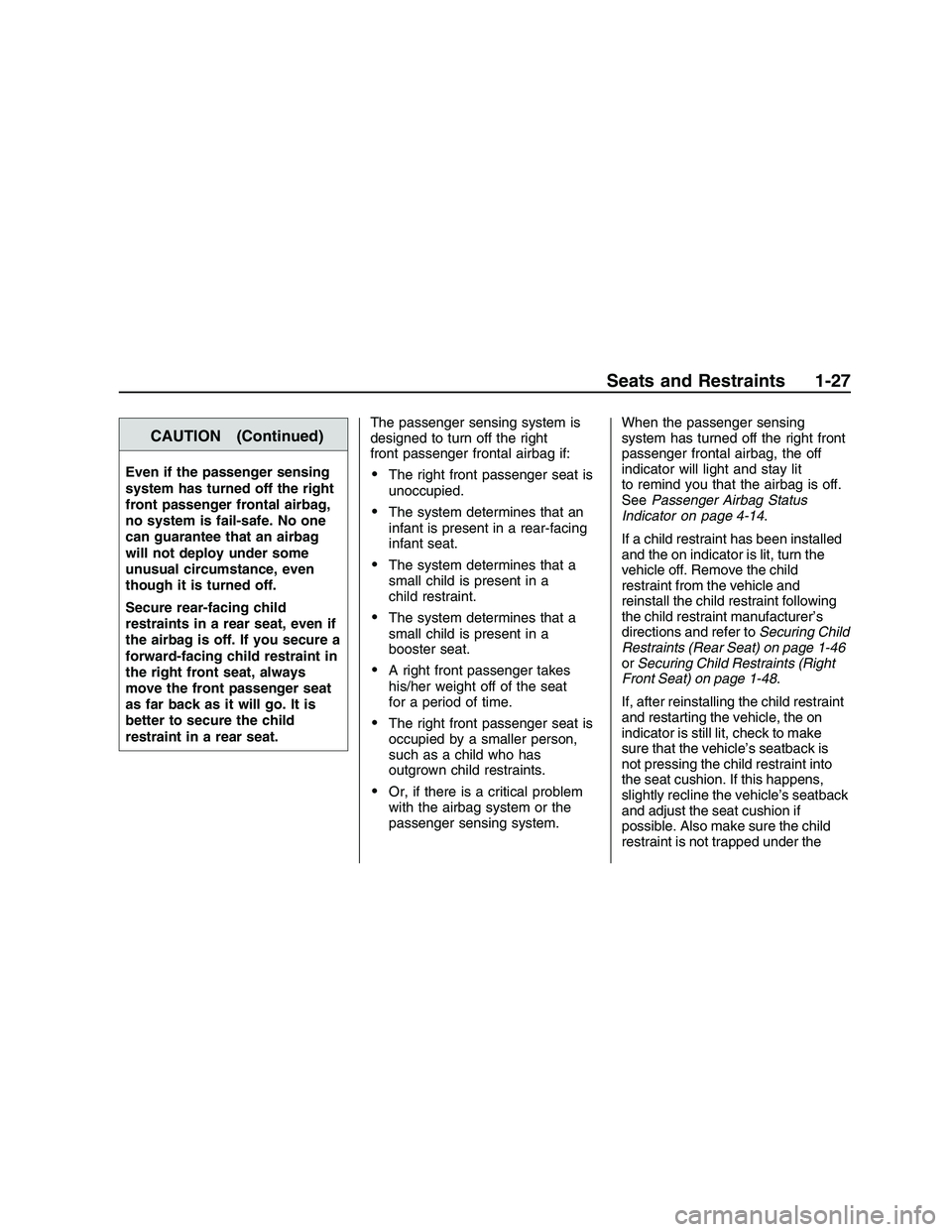
CAUTION (Continued)
Even if the passenger sensing
system has turned off the right
front passenger frontal airbag,
no system is fail-safe. No one
can guarantee that an airbag
will not deploy under some
unusual circumstance, even
though it is turned off.
Secure rear-facing child
restraints in a rear seat, even if
the airbag is off. If you secure a
forward-facing child restraint in
the right front seat, always
move the front passenger seat
as far back as it will go. It is
better to secure the child
restraint in a rear seat.The passenger sensing system is
designed to turn off the right
front passenger frontal airbag if:The right front passenger seat is
unoccupied.
The system determines that an
infant is present in a rear-facing
infant seat.
The system determines that a
small child is present in a
child restraint.
The system determines that a
small child is present in a
booster seat.
A right front passenger takes
his/her weight off of the seat
for a period of time.
The right front passenger seat is
occupied by a smaller person,
such as a child who has
outgrown child restraints.
Or, if there is a critical problem
with the airbag system or the
passenger sensing system.When the passenger sensing
system has turned off the right front
passenger frontal airbag, the off
indicator will light and stay lit
to remind you that the airbag is off.
SeePassenger Airbag Status
Indicator on page 4-14.
If a child restraint has been installed
and the on indicator is lit, turn the
vehicle off. Remove the child
restraint from the vehicle and
reinstall the child restraint following
the child restraint manufacturer’s
directions and refer toSecuring Child
Restraints (Rear Seat) on page 1-46
orSecuring Child Restraints (Right
Front Seat) on page 1-48.
If, after reinstalling the child restraint
and restarting the vehicle, the on
indicator is still lit, check to make
sure that the vehicle’s seatback is
not pressing the child restraint into
the seat cushion. If this happens,
slightly recline the vehicle’s seatback
and adjust the seat cushion if
possible. Also make sure the child
restraint is not trapped under the
Seats and Restraints 1-27
2008 - Pontiac G8 Owner Manual
Page 32 of 334
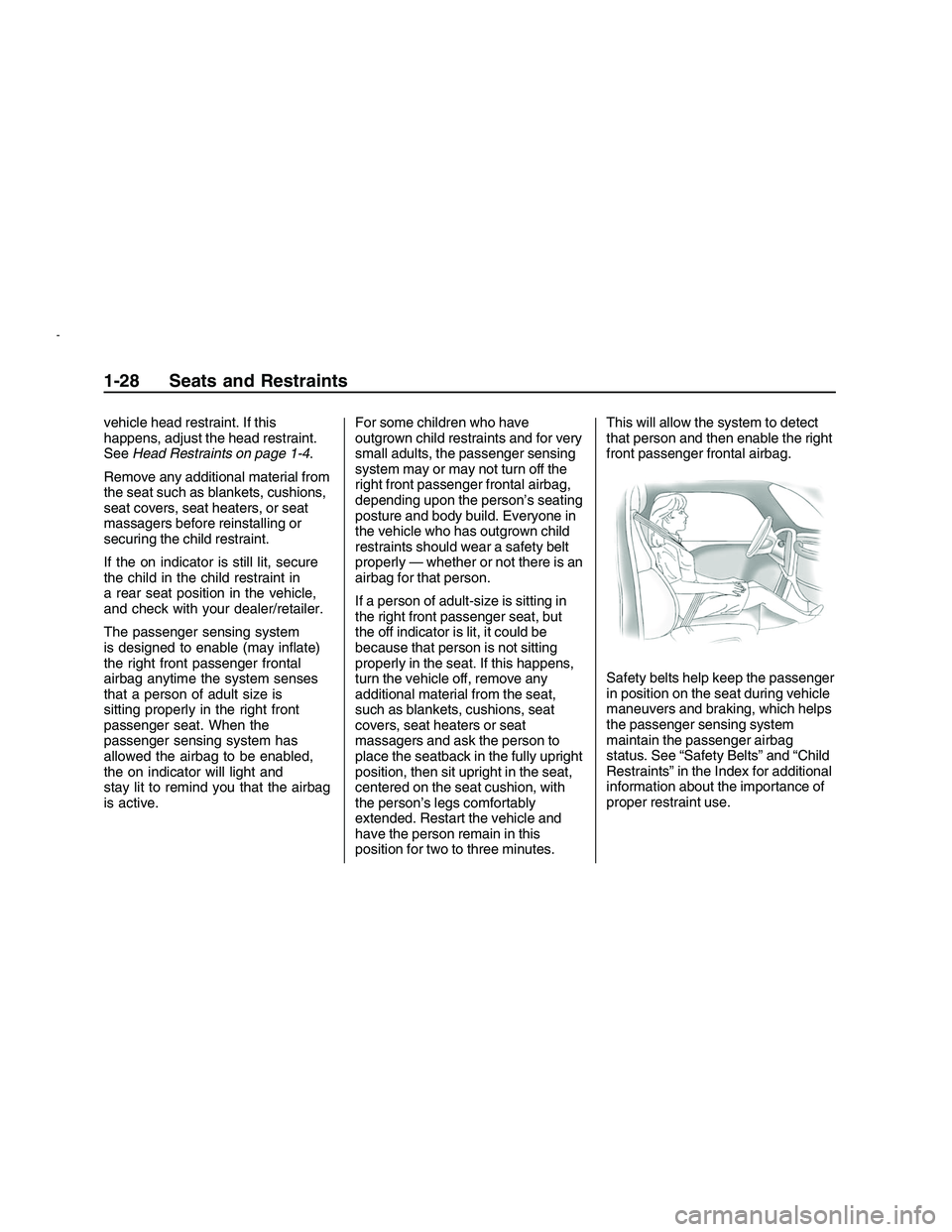
vehicle head restraint. If this
happens, adjust the head restraint.
SeeHead Restraints on page 1-4.
Remove any additional material from
the seat such as blankets, cushions,
seat covers, seat heaters, or seat
massagers before reinstalling or
securing the child restraint.
If the on indicator is still lit, secure
the child in the child restraint in
a rear seat position in the vehicle,
and check with your dealer/retailer.
The passenger sensing system
is designed to enable (may in�ate)
the right front passenger frontal
airbag anytime the system senses
that a person of adult size is
sitting properly in the right front
passenger seat. When the
passenger sensing system has
allowed the airbag to be enabled,
the on indicator will light and
stay lit to remind you that the airbag
is active.For some children who have
outgrown child restraints and for very
small adults, the passenger sensing
system may or may not turn off the
right front passenger frontal airbag,
depending upon the person’s seating
posture and body build. Everyone in
the vehicle who has outgrown child
restraints should wear a safety belt
properly — whether or not there is an
airbag for that person.
If a person of adult-size is sitting in
the right front passenger seat, but
the off indicator is lit, it could be
because that person is not sitting
properly in the seat. If this happens,
turn the vehicle off, remove any
additional material from the seat,
such as blankets, cushions, seat
covers, seat heaters or seat
massagers and ask the person to
place the seatback in the fully upright
position, then sit upright in the seat,
centered on the seat cushion, with
the person’s legs comfortably
extended. Restart the vehicle and
have the person remain in this
position for two to three minutes.This will allow the system to detect
that person and then enable the right
front passenger frontal airbag.
Safety belts help keep the passenger
in position on the seat during vehicle
maneuvers and braking, which helps
the passenger sensing system
maintain the passenger airbag
status. See “Safety Belts” and “Child
Restraints” in the Index for additional
information about the importance of
proper restraint use.
1-28 Seats and Restraints
2008 - Pontiac G8 Owner Manual
Page 33 of 334
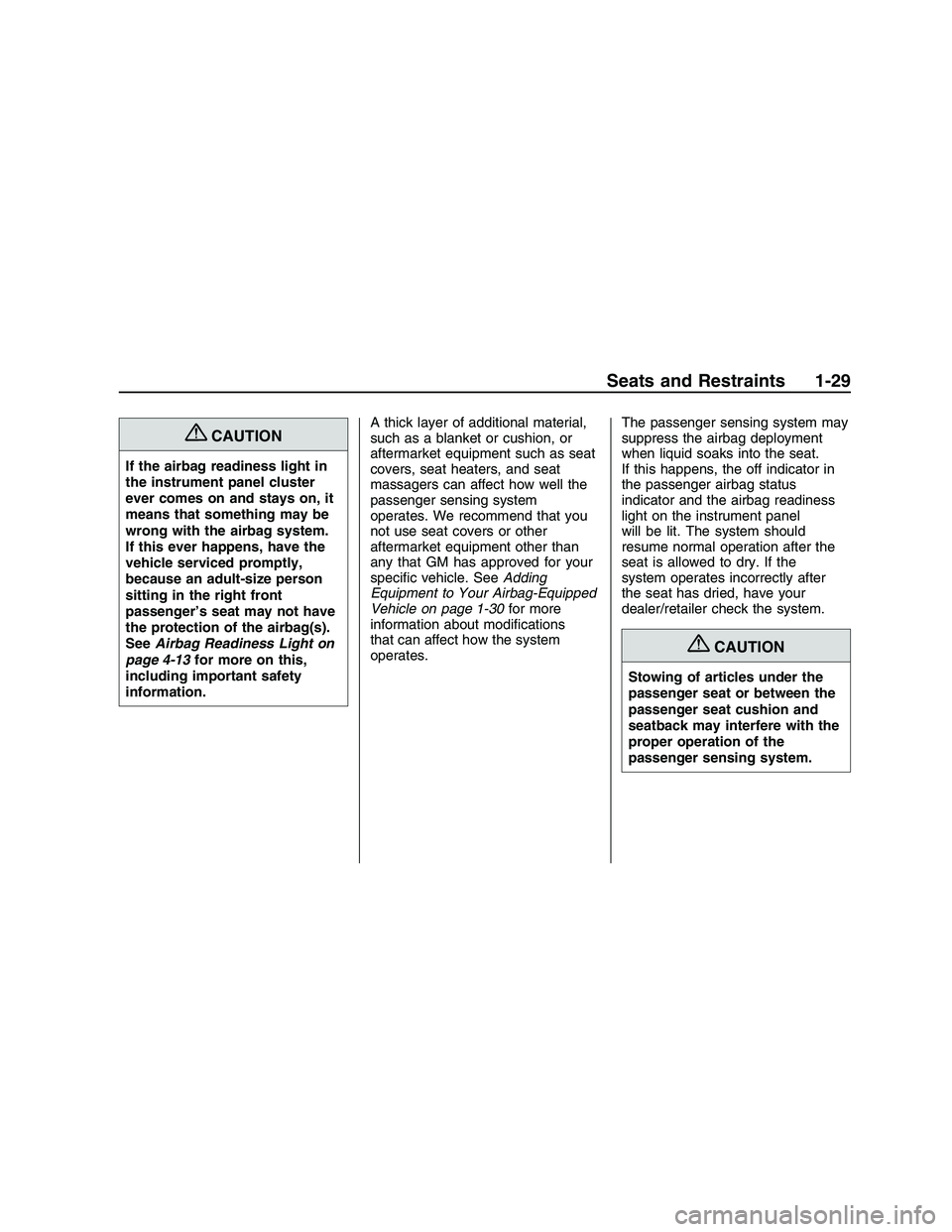
{CAUTION
If the airbag readiness light in
the instrument panel cluster
ever comes on and stays on, it
means that something may be
wrong with the airbag system.
If this ever happens, have the
vehicle serviced promptly,
because an adult-size person
sitting in the right front
passenger’s seat may not have
the protection of the airbag(s).
SeeAirbag Readiness Light on
page 4-13for more on this,
including important safety
information.A thick layer of additional material,
such as a blanket or cushion, or
aftermarket equipment such as seat
covers, seat heaters, and seat
massagers can affect how well the
passenger sensing system
operates. We recommend that you
not use seat covers or other
aftermarket equipment other than
any that GM has approved for your
speci�c vehicle. SeeAdding
Equipment to Your Airbag-Equipped
Vehicle on page 1-30for more
information about modi�cations
that can affect how the system
operates.The passenger sensing system may
suppress the airbag deployment
when liquid soaks into the seat.
If this happens, the off indicator in
the passenger airbag status
indicator and the airbag readiness
light on the instrument panel
will be lit. The system should
resume normal operation after the
seat is allowed to dry. If the
system operates incorrectly after
the seat has dried, have your
dealer/retailer check the system.
{CAUTION
Stowing of articles under the
passenger seat or between the
passenger seat cushion and
seatback may interfere with the
proper operation of the
passenger sensing system.
Seats and Restraints 1-29
2008 - Pontiac G8 Owner Manual
Page 34 of 334
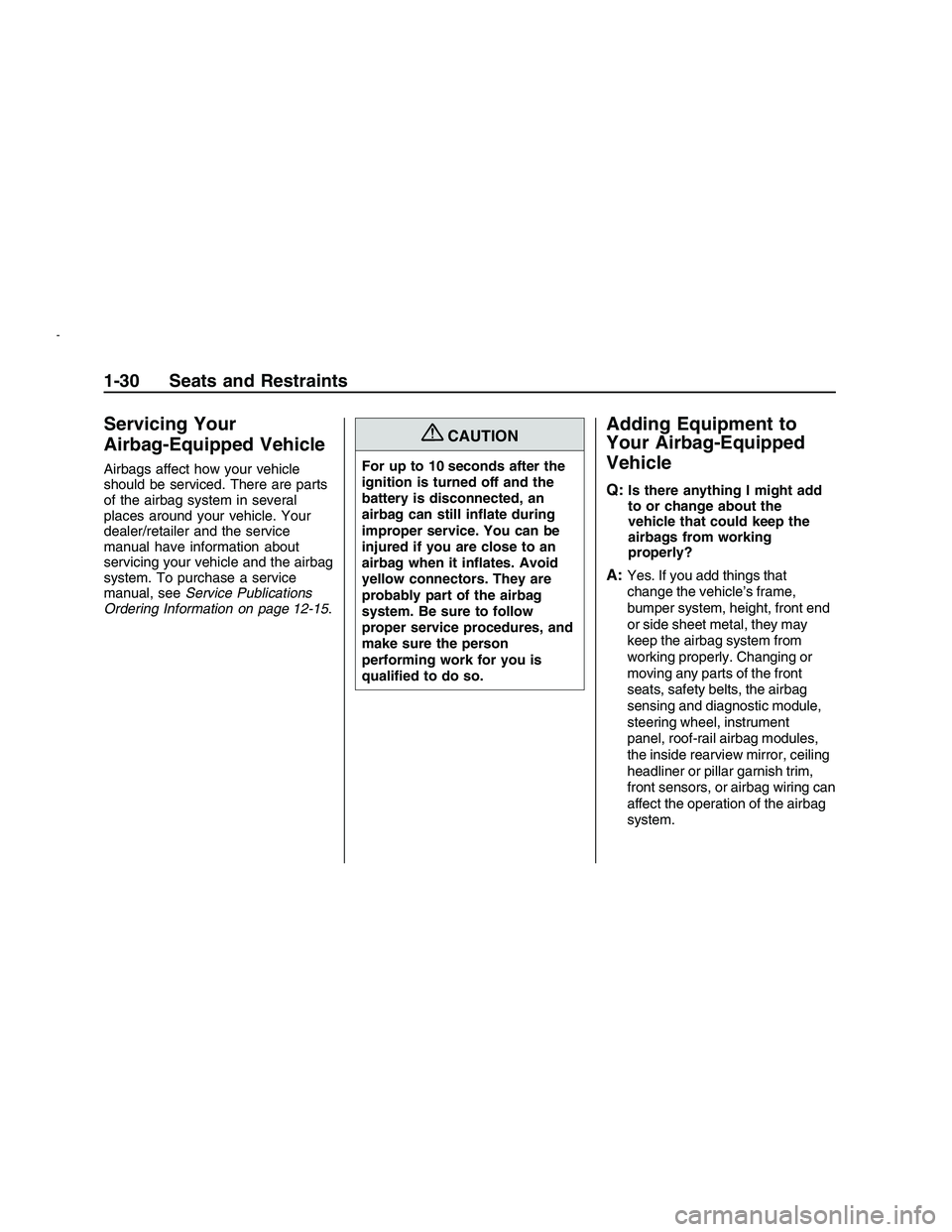
Servicing Your
Airbag-Equipped Vehicle
Airbags affect how your vehicle
should be serviced. There are parts
of the airbag system in several
places around your vehicle. Your
dealer/retailer and the service
manual have information about
servicing your vehicle and the airbag
system. To purchase a service
manual, seeService Publications
Ordering Information on page 12-15.
{CAUTION
For up to 10 seconds after the
ignition is turned off and the
battery is disconnected, an
airbag can still in�ate during
improper service. You can be
injured if you are close to an
airbag when it in�ates. Avoid
yellow connectors. They are
probably part of the airbag
system. Be sure to follow
proper service procedures, and
make sure the person
performing work for you is
quali�ed to do so.
Adding Equipment to
Your Airbag-Equipped
Vehicle
Q:Is there anything I might add
to or change about the
vehicle that could keep the
airbags from working
properly?
A:Yes. If you add things that
change the vehicle’s frame,
bumper system, height, front end
or side sheet metal, they may
keep the airbag system from
working properly. Changing or
moving any parts of the front
seats, safety belts, the airbag
sensing and diagnostic module,
steering wheel, instrument
panel, roof-rail airbag modules,
the inside rearview mirror, ceiling
headliner or pillar garnish trim,
front sensors, or airbag wiring can
affect the operation of the airbag
system.
1-30 Seats and Restraints
2008 - Pontiac G8 Owner Manual
Page 35 of 334

In addition, the vehicle has a
passenger sensing system for the
right front passenger position,
which includes sensors that are
part of the passenger’s seat. The
passenger sensing system may
not operate properly if the original
seat trim is replaced with non-GM
covers, upholstery or trim, or with
GM covers, upholstery or trim
designed for a different vehicle.
Any object, such as an
aftermarket seat heater or a
comfort enhancing pad or device,
installed under or on top of the
seat fabric, could also interfere
with the operation of the
passenger sensing system.
This could either prevent proper
deployment of the passenger
airbag(s) or prevent the
passenger sensing system from
properly turning off the passenger
airbag(s). SeePassenger
Sensing System on page 1-26.If you have any questions
about this, you should contact
Customer Assistance before you
modify your vehicle. The phone
numbers and addresses for
Customer Assistance are in
Step Two of the Customer
Satisfaction Procedure in this
manual. SeeCustomer
Satisfaction Procedure on
page 12-1.
Q:Because I have a disability,
I have to get my vehicle
modi�ed. How can I �nd out
whether this will affect my
airbag system?
A:If you have questions, call
Customer Assistance. The phone
numbers and addresses for
Customer Assistance are in
Step Two of the Customer
Satisfaction Procedure in this
manual. SeeCustomer
Satisfaction Procedure on
page 12-1.In addition, your dealer/retailer
and the service manual have
information about the location of the
airbag sensors, sensing and
diagnostic module and airbag wiring.
Airbag System Check
The airbag system does not need
regularly scheduled maintenance or
replacement. Make sure the
airbag readiness light is working.
SeeAirbag Readiness Light
on page 4-13for more information.
Notice:If an airbag covering
is damaged, opened, or broken,
the airbag may not work properly.
Do not open or break the airbag
coverings. If there are any opened
or broken airbag covers, have
the airbag covering and/or airbag
module replaced. For the
location of the airbag modules,
seeWhat Makes an Airbag
Inflate? on page 1-24. See your
dealer/retailer for service.
Seats and Restraints 1-31
2008 - Pontiac G8 Owner Manual
Page 36 of 334

Replacing Airbag System
Parts After a Crash
{CAUTION
A crash can damage the airbag
systems in your vehicle.
A damaged airbag system
may not work properly and
may not protect you and your
passenger(s) in a crash,
resulting in serious injury or
even death. To help make sure
your airbag systems are
working properly after a crash,
have them inspected and any
necessary replacements made
as soon as possible.If an airbag in�ates, you will need to
replace airbag system parts. See
your dealer/retailer for service.
If the airbag readiness light stays on
after the vehicle is started or comes
on when you are driving, the
airbag system may not work
properly. Have the vehicle serviced
right away. SeeAirbag Readiness
Light on page 4-13for more
information.
Child Restraints
Older Children
Older children who have outgrown
booster seats should wear the
vehicle’s safety belts.
1-32 Seats and Restraints
2008 - Pontiac G8 Owner Manual
Page 37 of 334
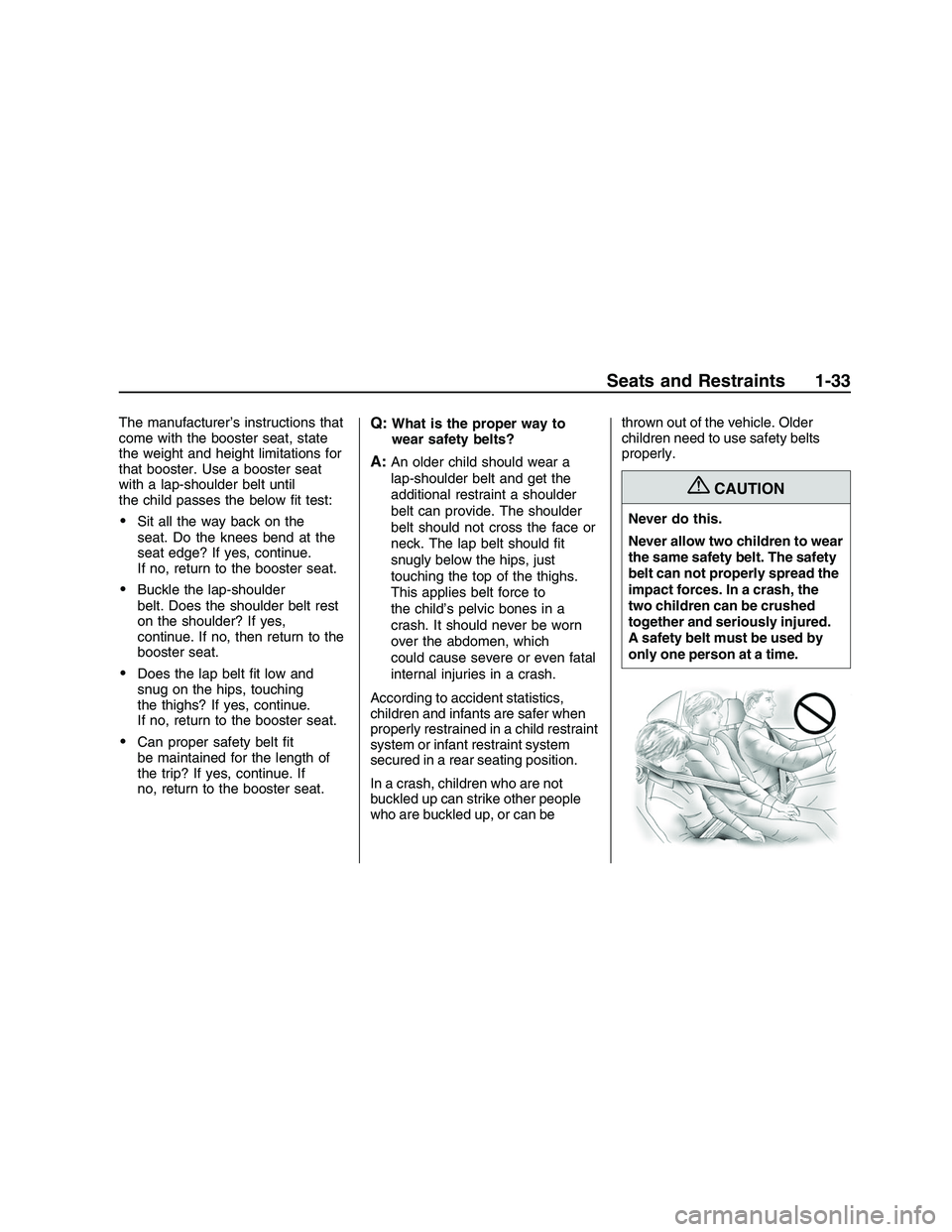
The manufacturer’s instructions that
come with the booster seat, state
the weight and height limitations for
that booster. Use a booster seat
with a lap-shoulder belt until
the child passes the below �t test:
Sit all the way back on the
seat. Do the knees bend at the
seat edge? If yes, continue.
If no, return to the booster seat.
Buckle the lap-shoulder
belt. Does the shoulder belt rest
on the shoulder? If yes,
continue. If no, then return to the
booster seat.
Does the lap belt �t low and
snug on the hips, touching
the thighs? If yes, continue.
If no, return to the booster seat.
Can proper safety belt �t
be maintained for the length of
the trip? If yes, continue. If
no, return to the booster seat.
Q:What is the proper way to
wear safety belts?
A:An older child should wear a
lap-shoulder belt and get the
additional restraint a shoulder
belt can provide. The shoulder
belt should not cross the face or
neck. The lap belt should �t
snugly below the hips, just
touching the top of the thighs.
This applies belt force to
the child’s pelvic bones in a
crash. It should never be worn
over the abdomen, which
could cause severe or even fatal
internal injuries in a crash.
According to accident statistics,
children and infants are safer when
properly restrained in a child restraint
system or infant restraint system
secured in a rear seating position.
In a crash, children who are not
buckled up can strike other people
who are buckled up, or can bethrown out of the vehicle. Older
children need to use safety belts
properly.
{CAUTION
Never do this.
Never allow two children to wear
the same safety belt. The safety
belt can not properly spread the
impact forces. In a crash, the
two children can be crushed
together and seriously injured.
A safety belt must be used by
only one person at a time.
Seats and Restraints 1-33
2008 - Pontiac G8 Owner Manual
Page 38 of 334
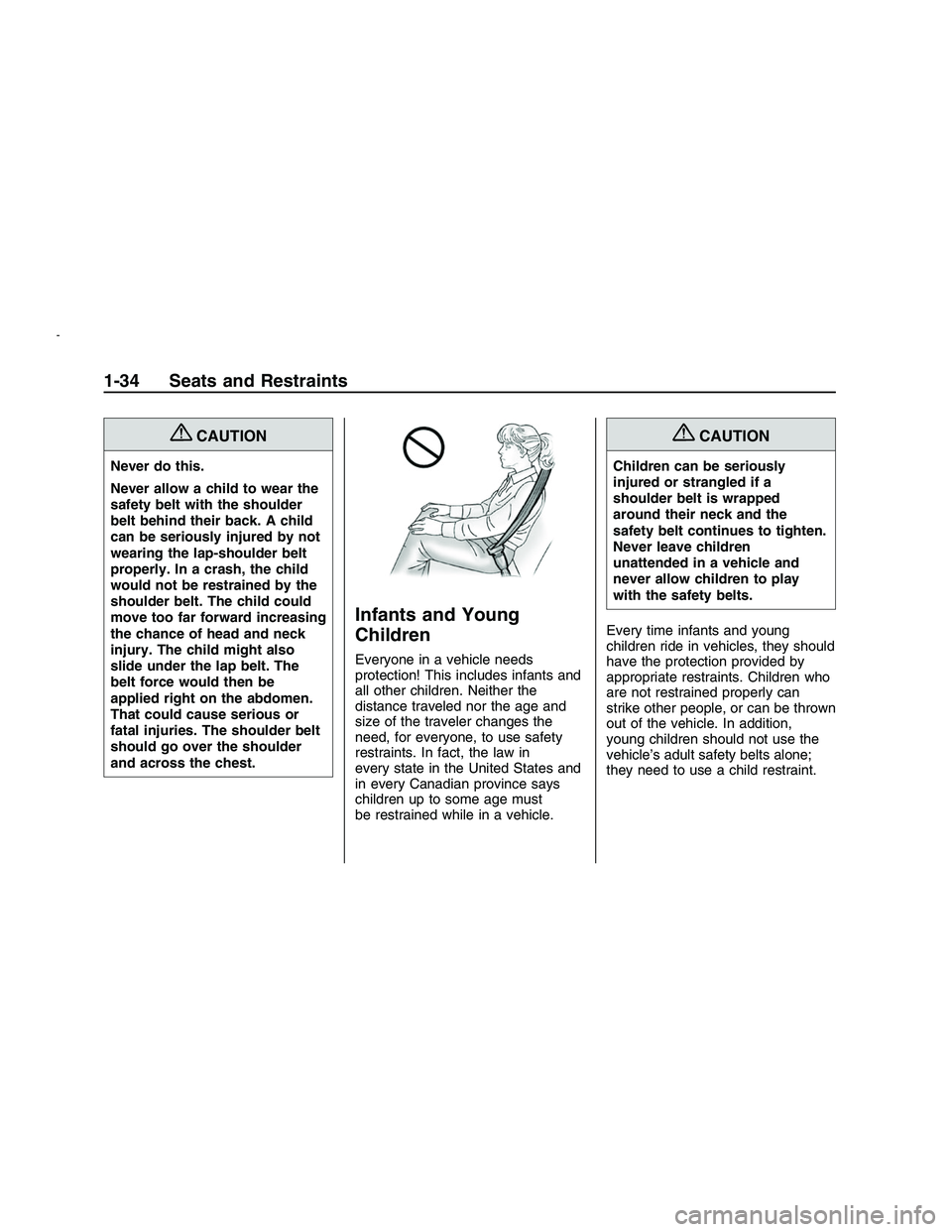
{CAUTION
Never do this.
Never allow a child to wear the
safety belt with the shoulder
belt behind their back. A child
can be seriously injured by not
wearing the lap-shoulder belt
properly. In a crash, the child
would not be restrained by the
shoulder belt. The child could
move too far forward increasing
the chance of head and neck
injury. The child might also
slide under the lap belt. The
belt force would then be
applied right on the abdomen.
That could cause serious or
fatal injuries. The shoulder belt
should go over the shoulder
and across the chest.
Infants and Young
Children
Everyone in a vehicle needs
protection! This includes infants and
all other children. Neither the
distance traveled nor the age and
size of the traveler changes the
need, for everyone, to use safety
restraints. In fact, the law in
every state in the United States and
in every Canadian province says
children up to some age must
be restrained while in a vehicle.
{CAUTION
Children can be seriously
injured or strangled if a
shoulder belt is wrapped
around their neck and the
safety belt continues to tighten.
Never leave children
unattended in a vehicle and
never allow children to play
with the safety belts.
Every time infants and young
children ride in vehicles, they should
have the protection provided by
appropriate restraints. Children who
are not restrained properly can
strike other people, or can be thrown
out of the vehicle. In addition,
young children should not use the
vehicle’s adult safety belts alone;
they need to use a child restraint.
1-34 Seats and Restraints
2008 - Pontiac G8 Owner Manual
Page 39 of 334
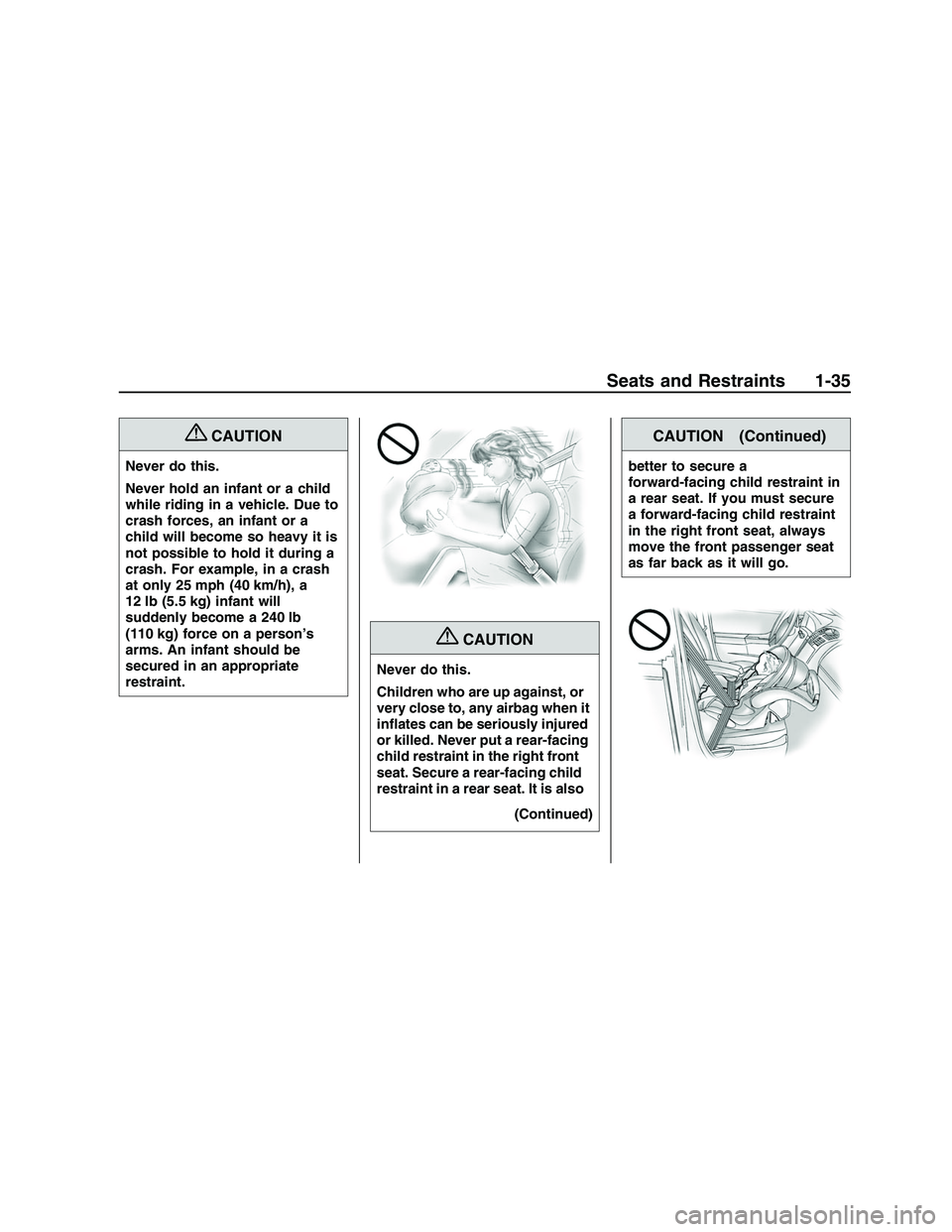
{CAUTION
Never do this.
Never hold an infant or a child
while riding in a vehicle. Due to
crash forces, an infant or a
child will become so heavy it is
not possible to hold it during a
crash. For example, in a crash
at only 25 mph (40 km/h), a
12 lb (5.5 kg) infant will
suddenly become a 240 lb
(110 kg) force on a person’s
arms. An infant should be
secured in an appropriate
restraint.
{CAUTION
Never do this.
Children who are up against, or
very close to, any airbag when it
in�ates can be seriously injured
or killed. Never put a rear-facing
child restraint in the right front
seat. Secure a rear-facing child
restraint in a rear seat. It is also
(Continued)
CAUTION (Continued)
better to secure a
forward-facing child restraint in
a rear seat. If you must secure
a forward-facing child restraint
in the right front seat, always
move the front passenger seat
as far back as it will go.
Seats and Restraints 1-35
2008 - Pontiac G8 Owner Manual
Page 40 of 334
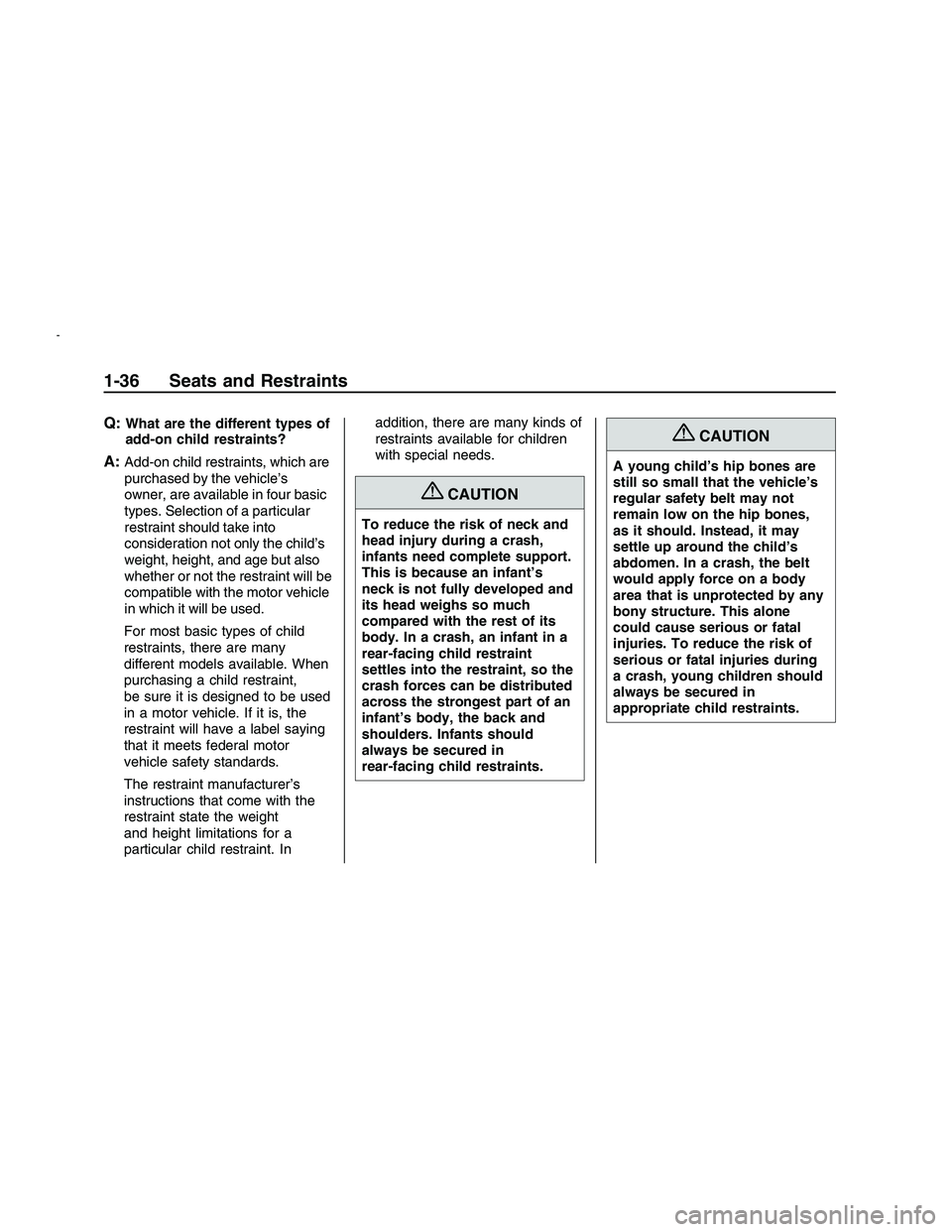
Q:What are the different types of
add-on child restraints?
A:Add-on child restraints, which are
purchased by the vehicle’s
owner, are available in four basic
types. Selection of a particular
restraint should take into
consideration not only the child’s
weight, height, and age but also
whether or not the restraint will be
compatible with the motor vehicle
in which it will be used.
For most basic types of child
restraints, there are many
different models available. When
purchasing a child restraint,
be sure it is designed to be used
in a motor vehicle. If it is, the
restraint will have a label saying
that it meets federal motor
vehicle safety standards.
The restraint manufacturer’s
instructions that come with the
restraint state the weight
and height limitations for a
particular child restraint. Inaddition, there are many kinds of
restraints available for children
with special needs.
{CAUTION
To reduce the risk of neck and
head injury during a crash,
infants need complete support.
This is because an infant’s
neck is not fully developed and
its head weighs so much
compared with the rest of its
body. In a crash, an infant in a
rear-facing child restraint
settles into the restraint, so the
crash forces can be distributed
across the strongest part of an
infant’s body, the back and
shoulders. Infants should
always be secured in
rear-facing child restraints.
{CAUTION
A young child’s hip bones are
still so small that the vehicle’s
regular safety belt may not
remain low on the hip bones,
as it should. Instead, it may
settle up around the child’s
abdomen. In a crash, the belt
would apply force on a body
area that is unprotected by any
bony structure. This alone
could cause serious or fatal
injuries. To reduce the risk of
serious or fatal injuries during
a crash, young children should
always be secured in
appropriate child restraints.
1-36 Seats and Restraints
2008 - Pontiac G8 Owner Manual